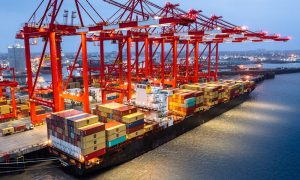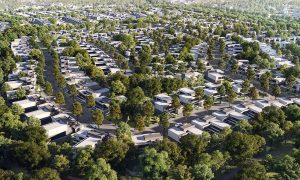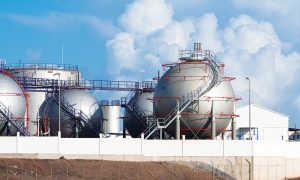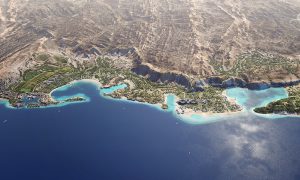Deep water strategy
Sohar Port Chief Executive Officer Andre Toet on his plans to raise the port’s profile as the gateway of choice for the GCC region

Situated at a strategic location on the Arabian Peninsula, just outside the Strait of Hormuz, Sohar has rapidly transformed itself from a quiet fishing village to a potential game changer in the Middle East’s ports sector. Sohar Port currently focuses on three clusters, namely logistics, petrochemicals and metals with agro-bulk slated to become the fourth. Its general cargo terminal is operated by C Steinweg Oman; the liquid cargo terminal is operated by a joint venture between Oiltanking and Odfjell while Hutchinson Whampoa operates the container terminal. A recent development of significance is the transfer of commercial cargo traffic from Muscat’s Port Sultan Qaboos to Sohar, which is expected to have a beneficial impact on the latter, in terms of both traffic growth and competitiveness.
Side by side, the port continues to build up and improve its infrastructure to realise the vision of becoming the gateway of choice into the Gulf Cooperation Council (GCC) market.
Making a case for investing in Sohar Port, its Chief Executive Officer (CEO) Andre Toet says that the city has in abundance the three main ingredients for a successful business: energy, land and manpower. This probably explains why the port has grown at 1000% ever since it welcomed its first cargo in 2007. This year, Sohar is poised to welcome 2,000 ships, a “mind boggling” achievement, given that it had “virtually nothing” to bank on when it started in 2004.
Do you see the relocation of cargo traffic from Muscat to Sohar turning into significant driver of growth?
If you look at the numbers, our own captive container traffic was 200,000 TEUs (Twenty-foot Equivalent Unit); from Muscat we will add approximately another 300,000 TEUs. Even with a total 500,000 TEUs, the volume is still small. I don’t see a massive increase in the number of ships, but where the container business is concerned, what will happen is an increase in the ship sizes.
Our strategy is to get the mainliners, the big ships, into Sohar. For long, Oman has been regarded as a feeder destination, fed from either Salalah or Jebel Ali, which made everything in Oman more expensive than in Dubai. This is because the freight difference between bringing the mainliners into Jebel Ali versus the feeder ships into Oman is huge. By combining volumes, we are aiming to create the critical mass so that we can get the big ships to come here, thereby reducing freight costs. Also, the Muscat Port cannot grow any further and is therefore, shifting focus to cruise tourism.
The shift from Muscat to Sohar will also advance our goal of becoming a gateway to the huge markets of upper Gulf, Iran, India and Pakistan. Their port infrastructure is not ready to receive huge volumes, so the very big ships can come to Oman while the smaller ones can go to Iran and India. Being just outside the Strait and at the same time, not being very far way, Sohar Port can play a very important role in these markets.
How are you ensuring that the port infrastructure keeps up with the trade dynamics?
From a cargo handling infrastructure standpoint, we have a massive deep-water jetty, which extends 1.3km into the open sea. One of the biggest of its kind globally, it is capable of handling some of the biggest bulk carriers that exist today. In the liquid business too, we are looking to expand; we are more or less full at the port from a land perspective but from a marine perspective, we still have scope to expand. We have also opened a new container terminal of 1.5m TEU capacity, and are aiming to expand the port’s container handling capacity to 2m TEU. The land is already there but the key walls are yet to be built, work on which will start in 2017.
By the end of this year, we are also looking to reclaim 180ha of land from the sea, possibly for marine infrastructure, depending on the kind of industry we are able to attract for this plot. Oman probably has the deepest water ports in the region easily accessible from the sea. Sohar Port, for instance, has a draft of 25m that can accommodate Vale ships.
There were recent reports in the press about Sohar Port’s diversification into agro-bulk. Could you elaborate on that?
Because everything in the Middle East has to be imported, we see an advantage in creating a dedicated agro berth. By doing this, we are creating massive opportunities to drive business for the freezone to go downstream. The Sultanate’s first dedicated agri-bulk terminal will handle wheat and grain shipments on behalf of the government and feedstock for Oman’s first sugar refinery. The construction of the refinery will begin in the third quarter of this year. We are happy with our four cluster approach because the spin offs from these will keep our hands full. You become a jack of all trades if you have too broad a focus and it also becomes difficult to manage and grow the business. However, this approach is only for the port. For the freezone, we have a different approach altogether.
What is the growth strategy for the freezone?
We are developing a massive piece of land – 4,500ha in area – for the freezone and plan to develop it in blocks of 500 ha each. In fact, we filled the first block much ahead of the deadline we had set for ourselves. We have expanded the second phase to include 600ha. If a customer from a different segment approaches us to set up the business in the freezone, we will not say no. We would rather see how to fit that customer in because they, in turn, could trigger a lot of additional business for the freezone.
With well-defined clusters already in place, we commissioned a study to fashion specific marketing campaigns for our focus markets, mainly India, parts of China, Korea, Saudi Arabia, the UAE and Brazil. We spend our marketing money in these markets but don’t forget that Oman itself is a source of investment for the freezone.
How about recent media reports about strengthening Sohar Port’s linkages with Singapore and the US?
Singapore has become the marine centre of the world. A lot of companies, from a marine perspective, are moving if not moved their head offices to Singapore. As an important transit point between East and West, a lot of decision-making power in the industry is concentrated there. We want Sohar to be closely linked to Singapore.
With US, Oman already has a free trade agreement. We believe Sohar Port should take advantage of this and attract more investors who may want to set up manufacturing facilities in the freezone to export to the US. We already have an industry that has completely moved out of Dubai to our freezone because their biggest export market is the US and in Dubai, they didn’t have the benefit of a free trade agreement.
Why did Sohar choose the landlord model for its operations?
While most ports juggle landlord and operator roles, we consciously chose to stay away from operations. When we try to attract private entities and internationally-reputed companies to Sohar, we automatically bring in their efficiency, productivity and global access.
When players like Odfjell and Steinweg come here, they not only invest heavily in Sohar but also popularise it within their global network, which attracts more customers. Moreover, in a landlord model, companies are responsible for their investments. We ensure that the basic infrastructure is in place but everything else is private investment. This also saves the government a lot of money.
How are you building up your connectivity into the hinterland?
You can have beautiful terminals but without good hinterland connections, you are a dead port. Sohar is unique because we enjoy good hinterland connections into the UAE and Oman by road. By the end of this year or early next year, we will also have new roads to Riyadh, which is the biggest consumer market in the Middle East. This will also raise Sohar’s profile as a competitive gateway into the GCC.
We expect the GCC Railway to boost our hinterland connectivity. Oman will first link Sohar to Al Ain and Abu Dhabi, followed by Salalah, Duqm, and Muscat. We are planning to set up on-dock rail facilities to provide direct access to the railway for bigger companies like Vale and Steinweg. We will also open a massive rail service centre between the port and the freezone.
The Sohar airport will be primarily utilised for cargo movement. Time sensitive products come by air and therefore, the airport could play an important role in developing this segment. We are looking to attract the big companies that do airplane maintenance to set up their base in Sohar. They will be able to put their spare parts in the freezone sans taxes, which is an interesting proposition for most people.
This was one of the reasons why we changed our branding to include the freezone. The more we started selling, the more we understood that the two are interlinked. The port cannot do without the freezone and vice-versa because both guarantee each other’s growth.
What kind of growth do you foresee for Sohar Port in the near future?
To have 1,000% growth in such a short period of time is an achievement. A lot of people look up to Jebel Ali and rightfully so. Jebel Ali is top-notch in the container business and bigger than Rotterdam. But they started in 1983 whereas we started in 2004. Therefore, the numbers we have achieved in such a short period of time is quite commendable.
We obviously foresee continued growth. But, how much? That is always difficult to predict. We are doing close to 50m tonnes/year and the aim is achieve 90m tonnes/year by 2022. We will see increased growth in the captive market – like Vale, Jindal and Sohar Aluminium – if they increase their business. But I foresee that the biggest growth will occur in the container business. Aided by the freezone, our captive and general cargo will grow at 5-6% per year.
Once the agro-business kicks off, it will be an accelerator for growth, increasing at the rate of few million tonnes per year. All in all, the port will enjoy a steady growth in business, whether it is project cargo to build the industries or manufacturing output through the container terminal.
How prepared is Sohar to accommodate future trends in the shipping sector?
We are currently handling 12,000 TEU ships but now I hear that 24,000 TEU is on the drawing table and is expected to be built in the next five years. The scale of ships is getting larger but this trend is no longer exclusive to the container business. You can see it in the liquid and the general cargo business as well.
In fact, without our present draft, we wouldn’t be able to get a Vale or a Maersk. Similarly we have to further enhance our marine layout, increase water depth and enable easy approach into the port to deal with the increase in scale. Port infrastructure should be able to keep up with trends and at Sohar, we are in a unique position to do that. Now we are using super-post Panamax cranes but if you want to handle the 18,000 TEU, you need to have the bigger super-post Panamax cranes; if we ever reach 24,000 TEU, you can only imagine how those cranes will look.
Does Sohar have a sustainability agenda? If so, what steps have you taken to implement that?
We follow very high environmental standards. Those who want to invest here have to comply with the Intergovernmental Panel on Climate Change (IPCC) standards and best available techniques. The port is in the IPPC green zone and has the most advanced air quality systems. We know exactly how much and what kind of emissions go into the air and we measure that all the time. We have invested in one of the most advanced e-nose systems in the world, which can immediately analyse a smell and identify the source in order to try to rectify it. We have had companies unable to join us due to the cost of compliance with IPPC rules. We are also the first port in the Middle East to become a member of the environment shipping index. Ships that comply with the index get a rebate on their port use.



















